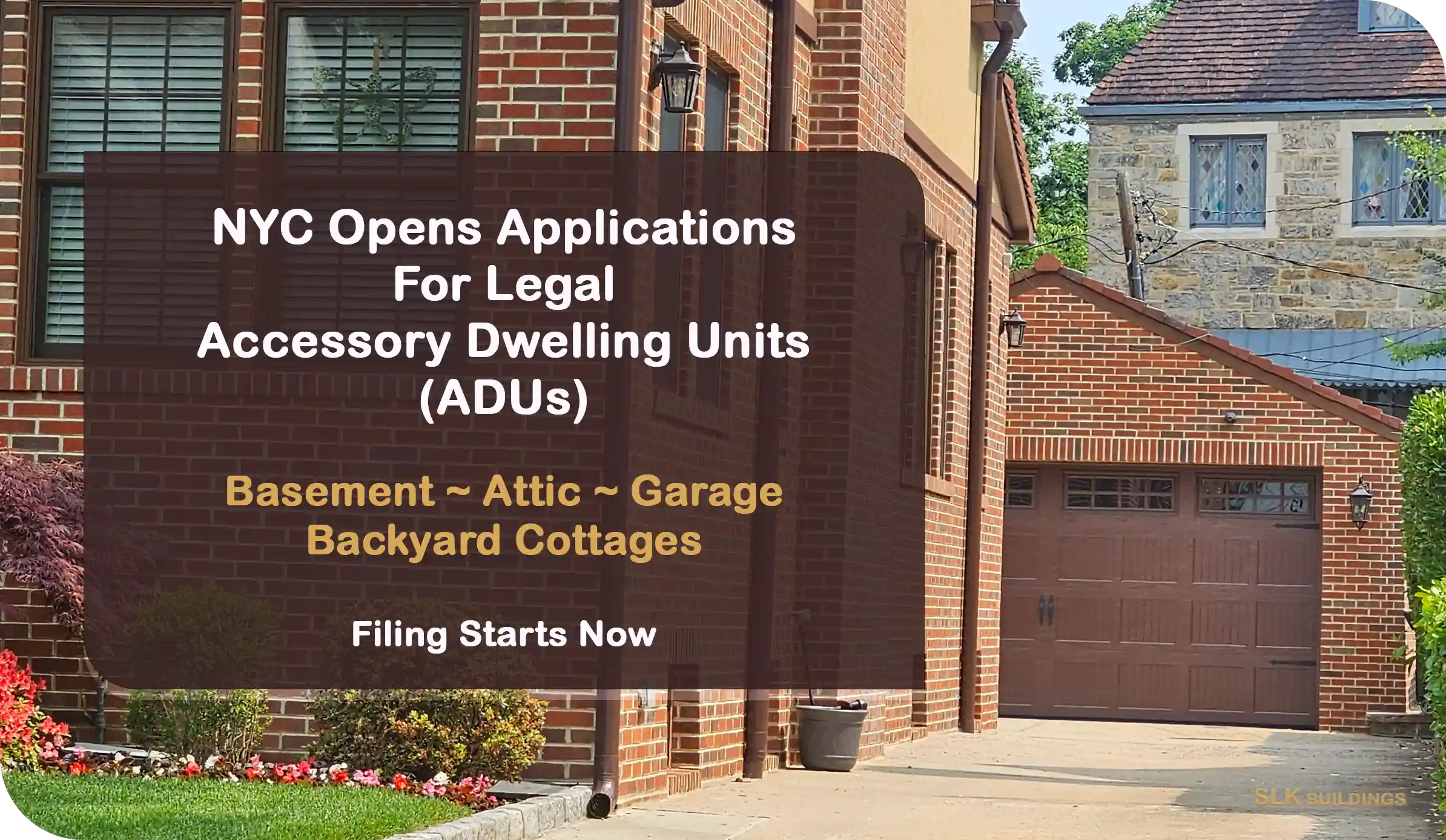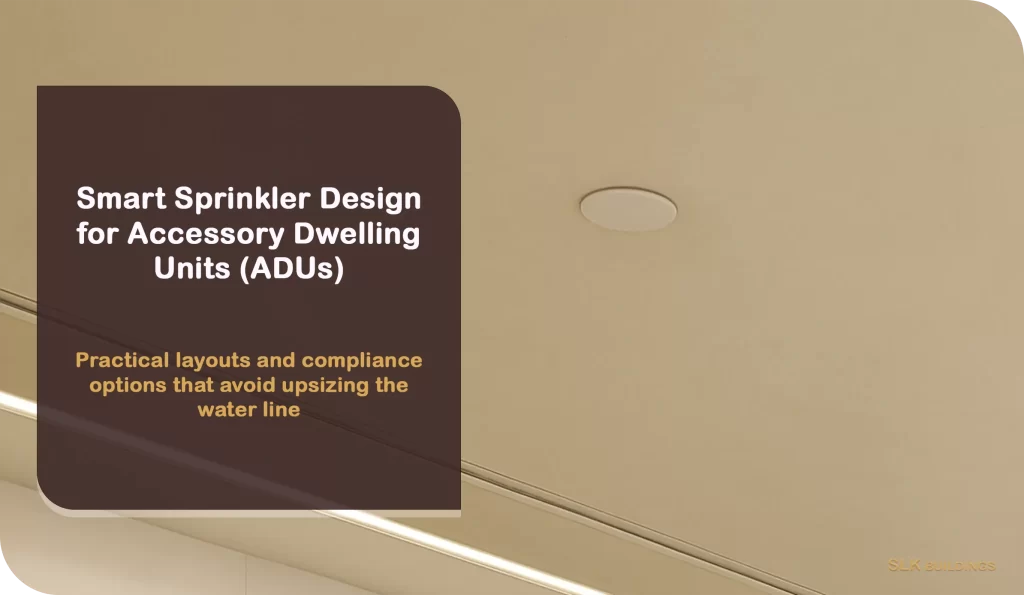NYC Opens Applications for Legal Accessory Dwelling Units (ADUs)

September 30, 2025 ~ New York City has officially opened the door for homeowners to create legal Accessory Dwelling Units (ADUs) ~ including basement apartments, attic conversions, and backyard cottages — under the Adams Administration’s City of Yes housing plan.
NYC Opens Applications for Legal Accessory Dwelling Units (ADUs)
This marks the most significant zoning reform since the 1960s, with the potential to create more than 80,000 new housing units across the five boroughs.
Disclosure: SLK Buildings is a private consulting and construction-management firm and is not affiliated with NYC DOB, HPD, HCR, or any government agency.
We provide zoning analysis, code compliance analysis (code interpretation), violation resolution, design with our partner Registered Architect, DOB filings, permit expediting, and construction coordination.
What is an ADU?
An Accessory Dwelling Unit (ADU) is a small, independent home located on the same lot as the main house. It may be attached to the primary dwelling or built separately.
- A small cottage in the backyard or above a garage
- A basement or cellar apartment
- A converted attic space
- A connected suite with its own kitchen and bathroom
The “ADU For You” Program
To encourage legal, safe construction, NYC launched a new homeowner resource called ADU For You.
Homeowners can browse the Pre-Approved Plan Library (PAPL) of city-vetted ADU designs.
Selected plans will connect owners directly with the design professionals who created them.
Technical partners include WXY, Habitat for Humanity NYC and Westchester, and KM Associates.
Neighborhood Restore HDFC will provide homeowner guidance during the process.
Key Requirements for New ADUs
Updated October 2025 – Snapshot of common eligibility and safety rules. Site-specific reviews still apply.
- Property type: The property must be a one- or two-family home.
- Ownership / occupancy: The homeowner must reside on the same zoning lot (in the primary dwelling or the ADU).
- Size cap: The ADU may be no larger than 800 sq ft.
- Location limits: Zoning and safety restrictions apply—certain historic districts, low-density residential areas, and flood-risk zones may be limited or prohibited.
- Separate entrance & signage: ADUs require a separate, code-compliant entrance; if the entrance is not visible from the street, a sign identifying the entrance is required.
Not sure if your lot qualifies? Start with a zoning analysis and a permit filing plan, and review potential ADU restrictions.
What Homeowners Can Now Do
Under the new rules, NYC homeowners may apply to build:
Basement ADUs in one- and two-family homes (subject to safety and flood regulations).
Attic ADUs, creating new habitable space within existing structures.
Backyard cottages (also called “tiny houses”) on the same lot as an existing one- or two-family dwelling.
Each unit must comply with Department of Buildings (DOB) safety standards on fire protection, occupancy, exits, and flood risk mitigation. Applications are now being accepted through the DOB NOW: Build Portal.
Safety First
DOB Commissioner Jimmy Oddo emphasized that ADUs must meet strict safety measures, including:
Additional egress and sprinkler systems for cellar ADUs.
Updated flood risk maps (from DEP) to prohibit subgrade ADUs in vulnerable areas.
Health Department testing for radon and chemical vapors in basements and cellars.
“These units must be not only legal, but safe,” said Deputy Mayor Jeff Roth.
Pilot Program for Existing Basements
In addition to new ADU applications, NYC is launching a pilot legalization program. Some existing basement and cellar apartments may qualify for a 10-year temporary authorization, provided they meet minimum health and safety standards.
This step could bring many previously informal apartments into compliance while protecting tenants.
What This Means for NYC Homeowners
For property owners in Staten Island, Brooklyn, Queens, Manhattan, and the Bronx, today’s change creates both:
Opportunities to generate rental income or provide housing for family members.
Responsibilities to follow zoning, safety, and code-compliance rules to avoid violations.
Frequently Asked Questions (FAQ)
Where do I file my ADU application?
Through DOB NOW: Build, typically by your Registered Design Professional. Many owners start with a pre-approved plan from the City’s PAPL.
How big can my ADU be?
Up to 800 sq ft, subject to zoning and life-safety rules (egress, fire protection, ventilation).
Do I need on-site parking?
No—new off-street parking is generally not required for ADUs under current rules.
How SLK Buildings Can Help
NYC has now opened applications for legal Accessory Dwelling Units (ADUs).
For some property owners, this new program creates a pathway to address basement and attic violations by converting these spaces into code-compliant apartments.
SLK Buildings can help determine whether ADU legalization is a viable solution for your violation case.
This marks the most significant zoning reform since the 1960s, with the potential to create more than 80,000 new housing units across the five boroughs.
At SLK Buildings, we guide homeowners and investors through the complexities of DOB filings, zoning compliance, and ADU approvals. From basement conversions to Plus One ADU applications, our team ensures your project is filed correctly and code-compliant — minimizing delays, penalties, and costly rejections.
📞 Contact SLK Buildings today for a consultation on how to safely and legally add an Accessory Dwelling Unit to your NYC property.
Plus One ADU
With NYC now officially accepting ADU applications, homeowners also have the opportunity to qualify under the Plus One ADU program.
Our recent update on NYC’s ADU application launch explains how these programs connect and what steps are required to move forward.
ADU Development in New York City
The launch of NYC’s ADU application process marks a major step for homeowners seeking rental income opportunities.
See our full coverage here: NYC Opens ADU Applications.
Paired with ADU development strategies in New York City, this creates new paths for long-term, code-compliant housing investment.
DOB Violations
For many owners facing basement or attic violations, NYC’s new ADU program offers a potential resolution path.
Our coverage of the ADU application launch explains how legalization can align with DOB compliance.
Explore more about DOB violations and how SLK Buildings helps owners resolve them.
